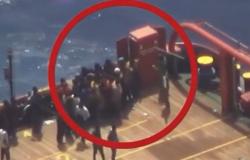Hamas welcomes but sets conditions. Netanyahu reiterates the proposal, but insists on eliminating the resistance
Positive signals from Hamas and Israel on Road map proposed by Israel to stop the conflict in Gaza and allow the release of the hostages, after the US president yesterday Joe Biden he returned forcefully with a speech at the White House to say that “It’s time for this war to end“, addressing in particular the Palestinian resistance, after months of pressure on the Israeli prime minister Benjamin Netanyahu. According to Egyptian media, a meeting will be held on Sunday 2 June between delegations from Cairo, Israel and the United States to discuss the reopening of the Rafah crossing. This was reported by the Egyptian TV Al-Qahera. “Egypt has confirmed to all parties its constant position on its non-willingness to reopen the Rafah crossing as long as ISRAEL maintains control of the Palestinian side”, explain Egyptian sources. It is not yet clear at what level tomorrow’s meeting will take place. Last May 7, the Israelis took control of the Palestinian side of the Rafah crossing in an operation that blocked the sending of humanitarian aid to Gaza.
In the meantime, however, “Hamas views it positively” the contents of Biden’s speech on Friday regarding “a permanent ceasefire, the withdrawal of Israeli forces from Gaza, reconstruction and prisoner exchange“, the Palestinian movement said in a statement. But even if Hamas leaders abroad expressed support for Israel’s proposals put forward by Biden, they recalled that the final answer lies in Yahya Sinwar And Mohammed Deif, leaders of the Islamic faction in Gaza. She reported it Haaretzaccording to which internal Hamas sources said they were waiting to receive an official document from Qatar.
The ceasefire proposal is developed in three phases. The first, with “a full and complete ceasefire” lasting six weeks, “the withdrawal of Israeli forces from all populated areas of Gaza and the release of a certain number of hostages including women, elderly, wounded in exchange of hundreds of Palestinian prisoners”. At this juncture, Palestinian civilians will be able to return to their homes and neighborhoods in all areas of Gaza, including the north, added the American president, specifying that humanitarian aid will increase. Phase two “envisages the definitive cessation of hostilities based on the negotiations that will take place in phase one”. Finally, phase three, in which “an important reconstruction plan” for the Strip will begin.
Now it is the true Hamas military who must implement the details of the agreement, starting with the release of the hostages. According to the Israeli newspaper HaaretzIslamic Jihad is also examining the roadmap but with “suspected“. Despite this possible truce, Israeli Prime Minister Netanyahu made it known that “Israel’s conditions for ending the war have not changed”. Therefore, “the destruction of Hamas’s military and government capabilities, the liberation of all hostages and the guarantee that Gaza no longer poses a threat to Israel.”
From the Israeli opposition Yair Lapid he asked the prime minister Benjamin Netanyahu to accept the ceasefire proposal. “The Israeli government cannot ignore President Biden’s important speech. There is an agreement on the table and it must be done – Lapid wrote on X -. I remind Netanyahu that he has a safety net from us for an agreement on release of hostages if Ben Gvir and Smotrich leave the government”.
A crucial point of the agreement concerns the hostages. There Road map “he will bring all the hostages home, secure Israel and create a better government for Gaza without Hamas in power. The agreement lays the foundation for a political solution that offers a better future for both Israelis and Palestinians“, added the head of the White House.
The US president’s intervention came on the same day that the IDF announced for the first time, after weeks of fighting, that it had moved to the center of Rafah. The military spokesman gave an account of a “evolution” gradual in the ongoing battle in the southernmost city of Gaza. The operation also concerns the ‘Philadelphia Corridor’, the strip of land that runs along the border with Egypt in Gaza now under Israeli control and where pressure is growing. The army’s objective, the spokesperson explained, is to eradicate Hamas structures also with special forces that are in action with “targeted” operations from the outskirts of the centre.
Rafah therefore remains a strategic hub not only from a military point of view but also, at its crossing, for the entry of humanitarian aid into the Palestinian enclave. Egypt has denounced that Israel has rejected trucks with aid for Gaza sent from Egypt at the Kerem Shalom crossing, where security checks take place. The reason, according to Cairo sources, would be the resumption of armed clashes between Israel and Hamas in the area and near Rafah on the Palestinian side. The same sources then added that the employees of the Rafah terminal on the Egyptian side confirmed the return, for this reason, of dozens of trucks of humanitarian aid to the logistics warehouses of the airport.
RELATED ARTICLES
Gaza, 12 Palestinians killed in raid on refugee camp in Bureij. IDF operates in central Rafah
Gaza, US ammunition used against tent cities. Ambulance hit in Rafah, paramedics killed
Israeli raid massacres civilians in a tent city in Rafah, charred bodies and decapitated children
The Hague orders Israel to stop the aggression in Rafah, Ben Gvir: ”Anti-Semites, we will occupy it”
Gaza, school bombed in Nuseirat refugee camp: four dead
In Gaza over 35,000 victims, Guterres: ”Shocked by escalation in Rafah”






